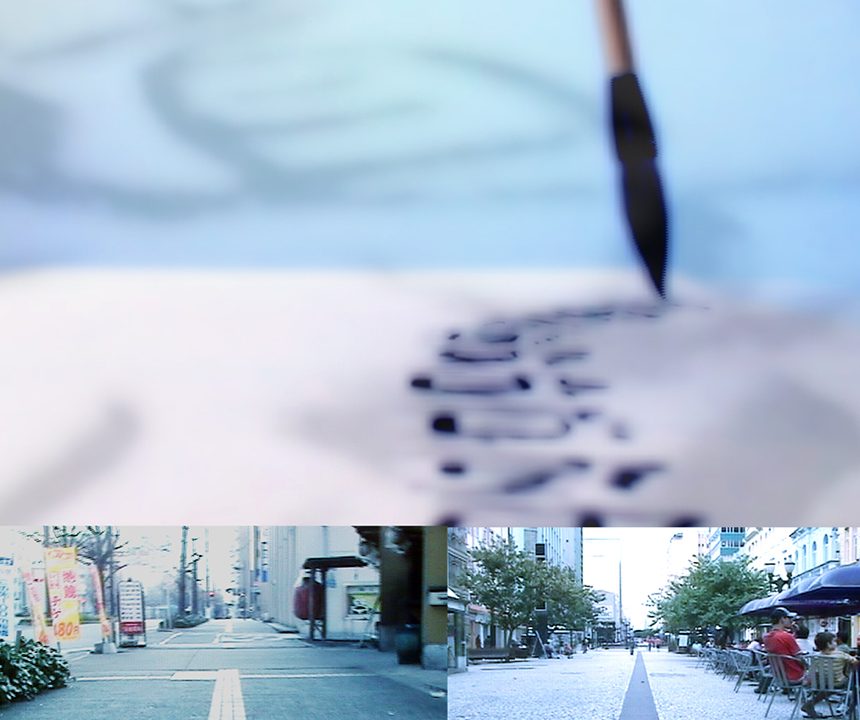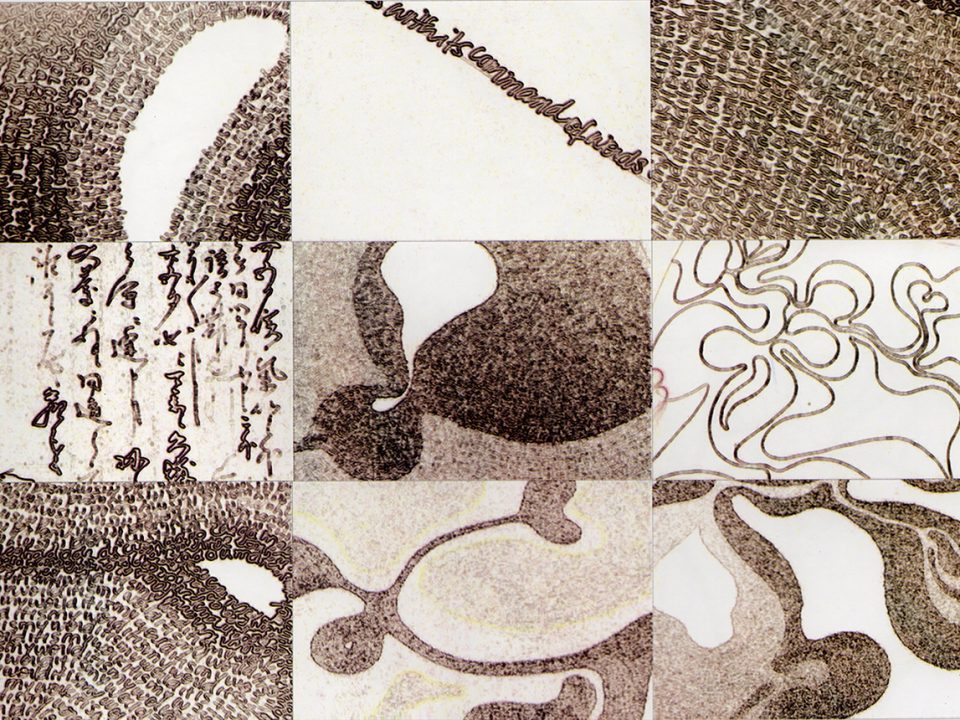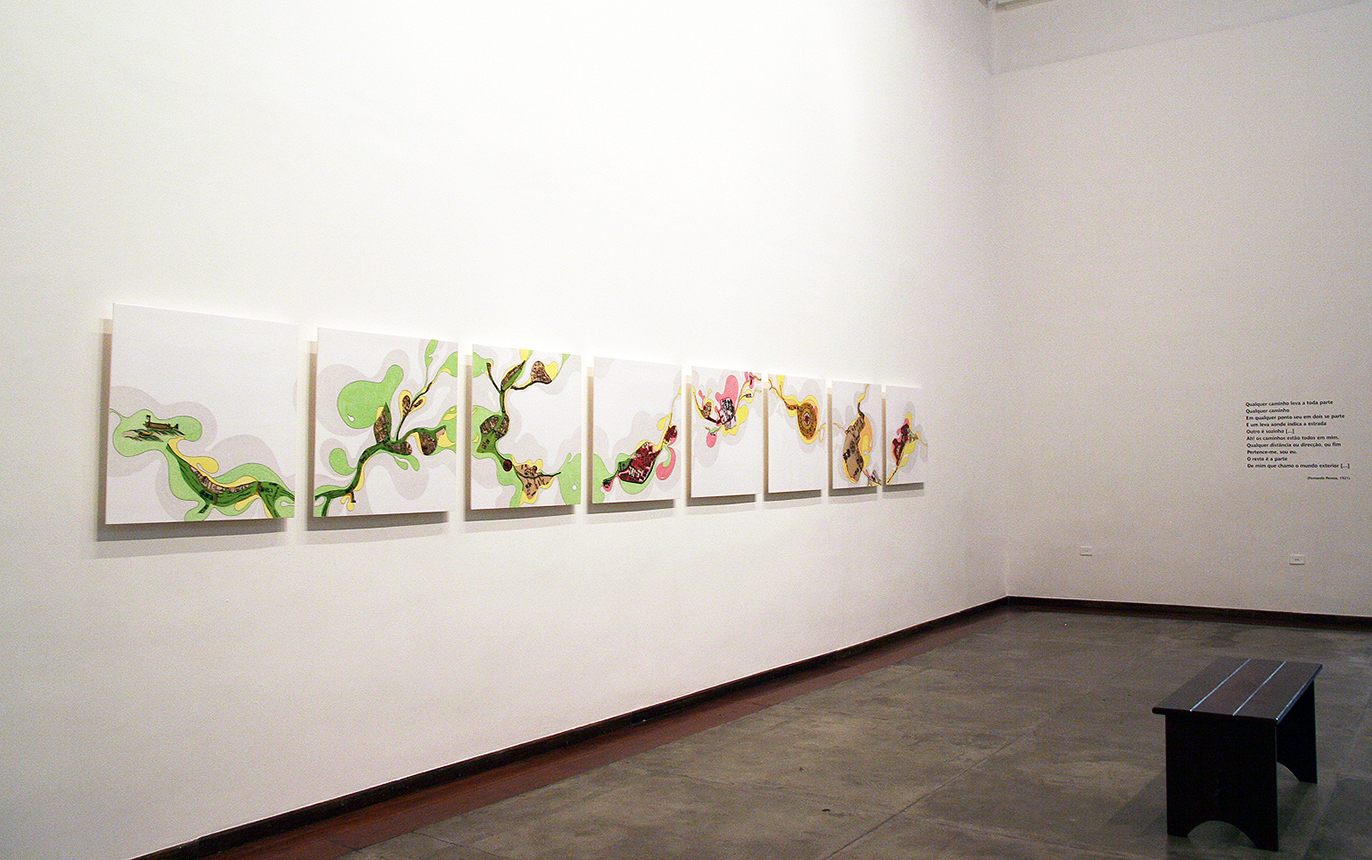
Solo exhibition at Contemporary Museum of Parana
Curitiba, Brazil, 2008
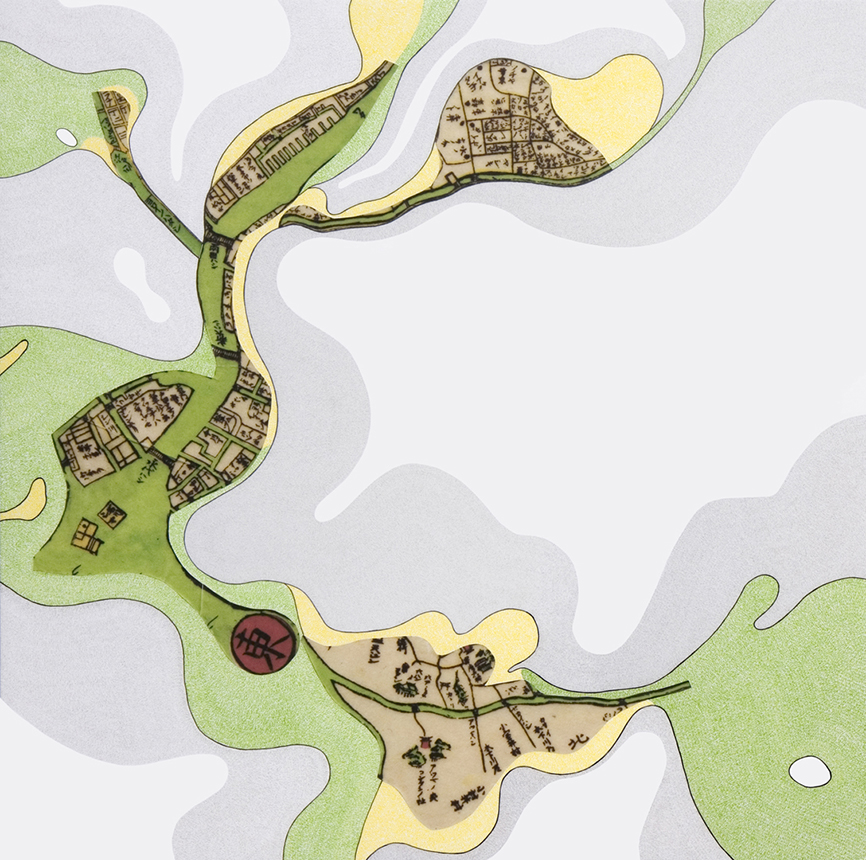
In(verses) Ways
Mixed media: Gel ink pen and collage on Japanese paper
8 drawings of 76x76cm/each, 2007/08
Exhibition Arts Challenge in Aichi, Aichi Arts Center, Japan 2008;
Exhibition New Art Brazil-Japan, Yokohama Civic Art Gallery, Japan, 2008;
Exhibition at Contemporary Museum of Parana, Brazil, 2008
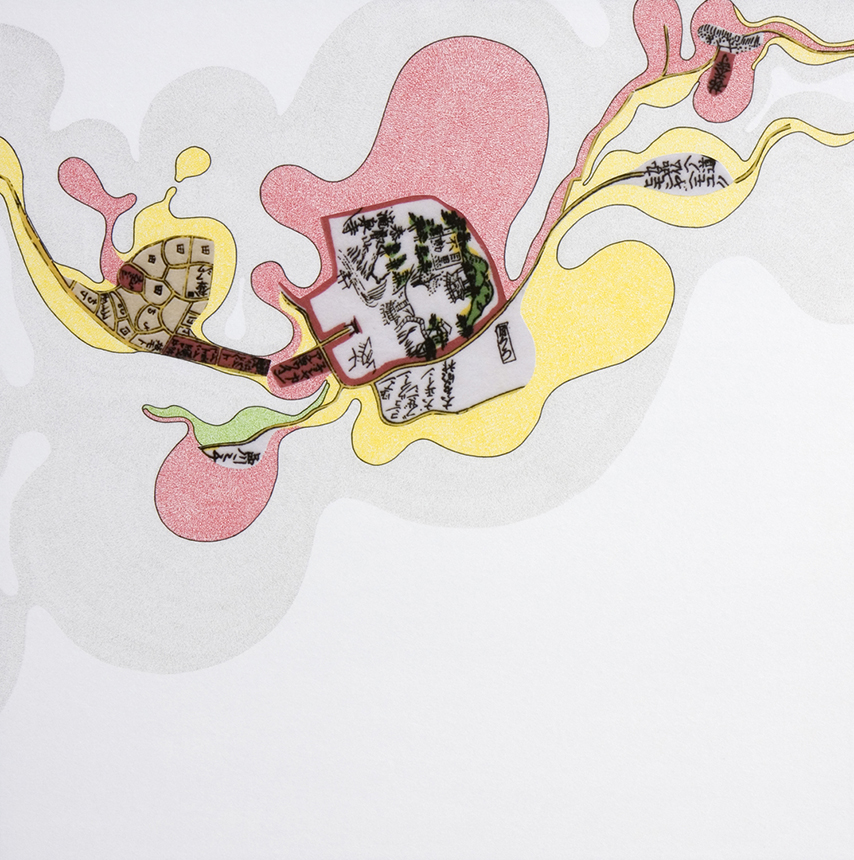
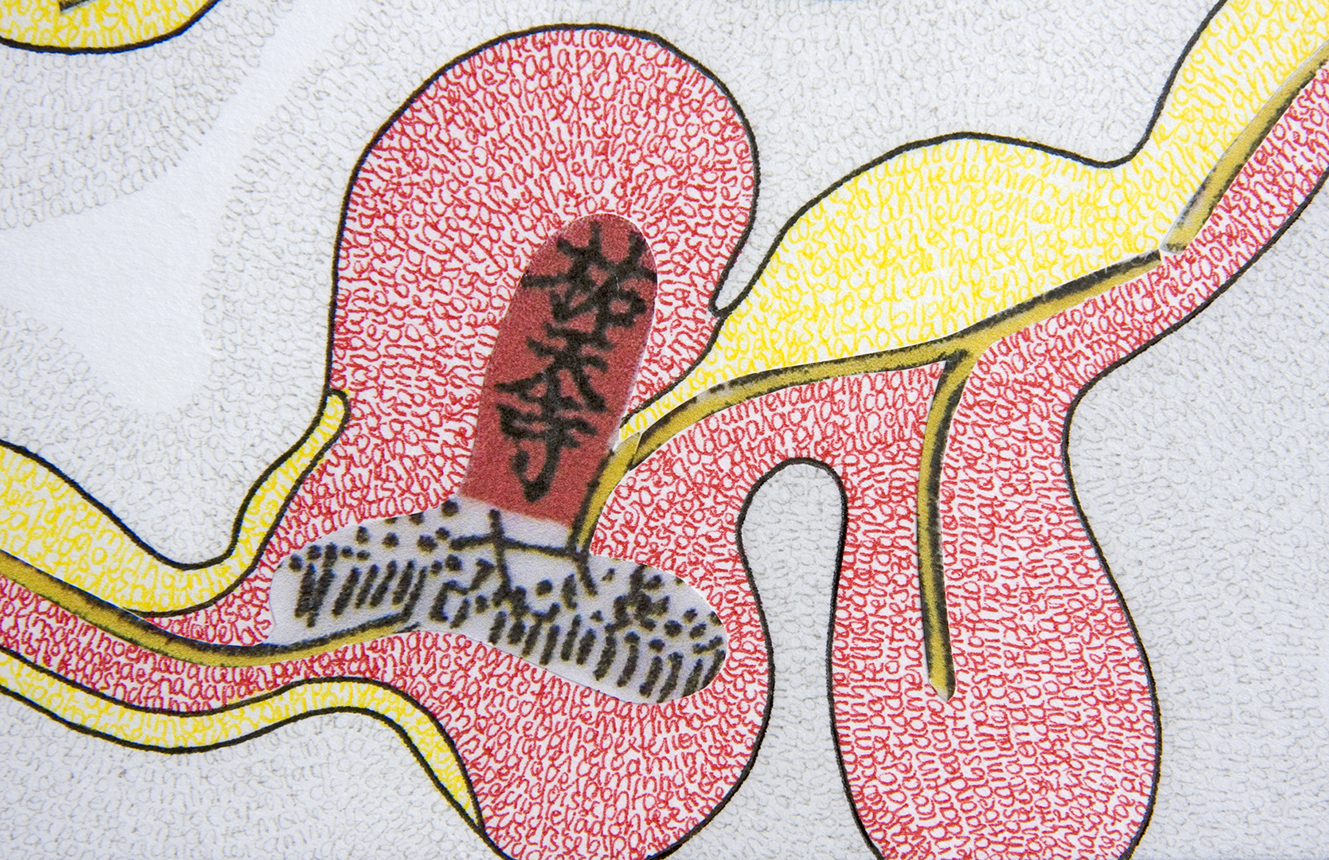
"In(verses) Ways is based on my journey: Japan-Brazil-Japan
The first Japan is more imaginary, known only through my mother and family, by old pictures, tradition of old songs and stories. An (in)existing place that was present in my childhood imagination and visible only in my family name and appearance.
The second journey Brazil-Japan is the reality, my true experience through my eyes and life. By this journey, I return to the first Japan, to the country where my roots are dormant, making the inverse way of my family’s history with an attempt to identify myself, looking for my own way.
In the middle of this journey, I find the poem of the Portuguese Poet Fernando Pessoa; “Any way leads to every where” (1921) 。In this poem, Pessoa says that any way can lead to every where, at any point it can be separated, divided, because all the ways are inside of us. Any direction, distance or end only belongs to us.
“Any way leads to every where
Every where
At any point in two is divided
One leads where it indicates the road
Another is alone
One leads to the end of simple road. Stops
Where it finishes
Another is the abstract margin
(…)
Ah! The ways are all inside of me.
Any distance or direction, or end
Belong to me, it is me. The rest is the part
Of me that I call the exterior world (…)” *
(Fernando Pessoa, 1921)
*translated by myself
I follow the Pessoa’s verses trying to merge the imaginary (my past) and the reality (my present) and intersecting them into my drawings. I take the imaginary Japan through old Japanese maps of Tokyo (of 200 years ago) and divide, cut, separate and transform them into my directions. An allusion of the pictorial images of my childhood; I can walk on the inexistent streets, enter the houses, read the family names and navigate the rivers… It is an attempt to return to that past and create a new reality, an identification process of the self.
As Welsh says about Invisibles Cities of Italo Calvino; “…the city outside the eyes – the city beyond the self – is invisible. Only the city inside the self can really be perceived; or rather, the only city that is perceived is the represented city inside the self” (John Welsh, University of Virginia).
Therefore, the imaginary country of my childhood returns to my present, it is inside of me. I follow my own way in the Poetic of Pessoa’s words, and my journey between Japan-Brazil-Japan becomes just one, without limits of time and space."
Erica, november, 2007
_______________________________________
Caminhos In(versos)
"Caminhos In(versos) se baseia no meu trajeto; Japão – Brasil – Japão.
O primeiro ambiente é um Japão imaginário, conhecido apenas pelas fotos antigas de família, canções tradicionais e estórias infantis narradas pela minha mãe. Um lugar (in)existente que sempre esteve presente na minha imaginação de criança e visível apenas em meu sobrenome e aparência.
O segundo caminho, entre Brasil – Japão, é a realidade, minha verdadeira experiência através do meu olhar e meu corpo. Por este trajeto, eu retorno ao primeiro Japão, ao país onde minhas raízes estão dormentes, e sigo o caminho inverso da minha família, numa tentativa de me identificar e encontrar meu próprio caminho.
Entre um trajeto e outro, encontro-me com o poema do poeta português Fernando Pessoa; “Qualquer caminho leva a toda parte” (1921). Nele, Pessoa reflete sobre os vários caminhos que podemos seguir, porém através de um jogo de palavras, o poeta revela que todos os caminhos levam-nos a toda parte, e em qualquer ponto, podemos separá-los e dividí-los. Podemos sim dissecá-los e partir para toda parte, pois todos os caminhos estão em nós. Assim, numa metáfora lúdica, o poeta brinca e nos faz refletir sobre as nossas escolhas;
“Qualquer caminho leva a toda a parte
Qualquer caminho
Em qualquer ponto seu em dois se parte
E um leva a onde indica a estrada
Outro é sozinho.
Uma leva ao fim da mera estrada.
Pára onde acabou.
Outra é a abstracta margem
[...]
Ah! os caminhos estão todos em mim.
Qualquer distância ou direcção, ou fim
Pertence-me, sou eu.
O resto é a parte
De mim que chamo o mundo exterior.
Mas o caminho deus eis se biparte
Em o que eu sou e o alheio a mim [...]“
Sigo os versos de Pessoa e entrecruzo suas palavras com as minhas, e contorno com formas e cores meu passado e meu presente, fundidos em um só. Do meu imaginário infantil, aproprio-me dos antigos mapas japoneses do período da Era Edo (1603-1868); divido, corto, separo e transformo-os em minhas direções. Assim, aludindo ao lúdico, posso caminhar em suas ruas e vielas, entrar em suas casas, navegar em seus rios… Uma tentativa em buscar a realidade num passado ausente e retransformá-la em meu presente, num processo de identificação do self (EU).
Assim como o crítico literário John Welsh, da University of Virginia, diz sobre As Cidades Invisíveis de Italo Calvino (Italy, 1972); “… a cidade que está além do olhar, a cidade atrás do self – é invisível. Apenas a cidade que está dentro do self pode ser realmente percebida, ou melhor, a única cidade que é percebida é a cidade “representada” dentro do self .
Assim, o país imaginário de infância retorna ao meu presente, ele mora dentro de mim. Sigo o meu caminho dentro da poética de Pessoa, e meu trajeto Japão-Brasil-Japão torna-se apenas um, sem limite físico-temporal."
Erica, novembro, 2007


